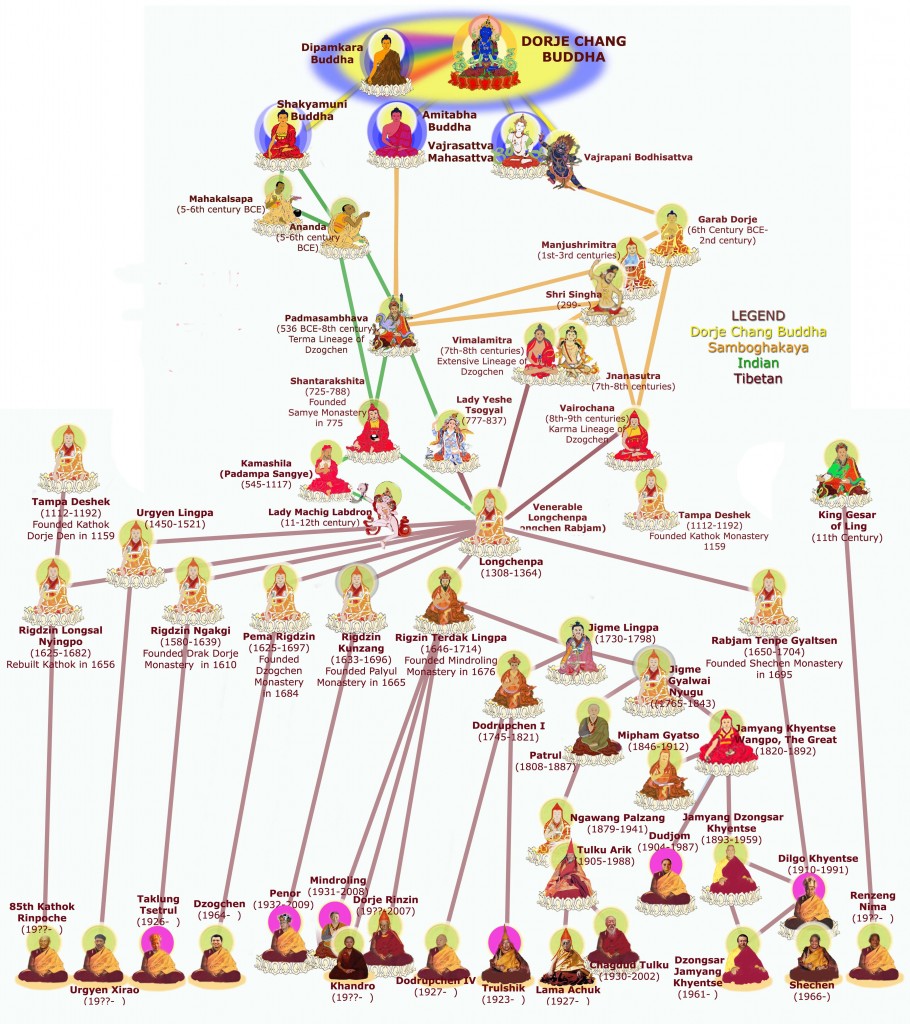 This school is the oldest in Tibet, tracing its roots to Guru Padmasambhava’s and other original transmissions in the 8th century. The great Mahasiddha and Dharma King Padmasambhava was brought to Tibet by King Trisong Detsen under the advice of the scholar-monk Master Shantarakshita. Guru Padmasambhava was brought to subdue the demons who were obstructing the introduction of Buddhism in Tibet. With Master Shantarakshita he established Tibet’s first monastery, Samye, in around 779 (there are differing dates). Master Shantarakshita also oversaw the translation of a large collection of Buddhist scriptures into Tibetan. His view based on a synthesis of Madyamaka, Yogacara, and Pramana Schools are expressed in the Madhyamakalamkara (Ornament of the Middle Way) and was the foundation for Tibetan teaching until the 15th century when Je Tsongkhapa’s interpretation of the Prasangika Madhyamaka supplanted it. Master Ju Mipham Gyatso attempted to resurrect Shantaraksha’s teachings and published the monumental commentary on those teachings in 1876 as the Speech of Delight.
This school is the oldest in Tibet, tracing its roots to Guru Padmasambhava’s and other original transmissions in the 8th century. The great Mahasiddha and Dharma King Padmasambhava was brought to Tibet by King Trisong Detsen under the advice of the scholar-monk Master Shantarakshita. Guru Padmasambhava was brought to subdue the demons who were obstructing the introduction of Buddhism in Tibet. With Master Shantarakshita he established Tibet’s first monastery, Samye, in around 779 (there are differing dates). Master Shantarakshita also oversaw the translation of a large collection of Buddhist scriptures into Tibetan. His view based on a synthesis of Madyamaka, Yogacara, and Pramana Schools are expressed in the Madhyamakalamkara (Ornament of the Middle Way) and was the foundation for Tibetan teaching until the 15th century when Je Tsongkhapa’s interpretation of the Prasangika Madhyamaka supplanted it. Master Ju Mipham Gyatso attempted to resurrect Shantaraksha’s teachings and published the monumental commentary on those teachings in 1876 as the Speech of Delight.
Shantarakshita warned the king that after his death around 788 there would be a major schism within the sangha. Some would favor the Ch’an or direct realization expounded by the Chinese Master Moheyan, while some would favor the gradual tantric methods of Indian Buddhism. Shantarakshita told the king that he should hold a debate between these two forces and decree that whoever won the debate would prevail and the other group should be expelled from Tibet. He also said that the king should have Shantarakshita’s major disciple, Kamashila (713-794), an attractive and excellent debater, represent the Indian point of view. Things happened as Shantarakshita had predicted and a debate was held. There is still controversy over what actually happened, but Kamashila was declared the winner. There was also some political considerations over unwanted Chinese influence atributed to this decision. What happened next also has several versions. In one, Kamashila was killed after the debate by Chinese assassins. However there is also a more elabrate version of Kamashila’s demise concerning him finding a diseased and contagious corpse by the side of the road and transferring his mindstream to the corpse via phowa, was able to move the corpse so as to save the nearby villagers of possible harm. An unattractive Indian mahasiddha named Padampa Sangyecame and saw the handsome remains that had been Kamashila and, in turn, assumed that form and left his ugly body instead. Padampa Sangye continued on his ascent in the himilaya to Tibet and thereby transmitted the Pacification of suffering teachings and the Indian form of Chod which contributed to the Mahamudra Chodd of Machig Labdron.
The six “Mother” monasteries that make up the major sub-sects within the Nyingma are Kathok Dorje Den (1159), founded by Tampa Deshek (Dampa Desheg 1112-1192) and rebuilt in 1656 by Rigdzin Longsal Nyingpo (1625-1682); Mindrolling (1676), founded by Rigdzin Terdak Lingpa (1646-1714) with H. H. Mindrolling Trichen (1931-2008) as its most recent head;Palyul (1665), founded by Pema Rigdzin Kunzang Sherab (1625-1697) with H. H. Penor Rinpoche (1932-2009) as its most recent head; Dzogchen (1684), founded by Dzogchen Pema Rigdzin (1625-1697) with Dharma King Tenzin Longdock Nyima (1974- ) as its current head in Tibet and Dharma King Jikme Losel Wangpo (1964- ) as its head in India; and Schechen (1695) founded by Rabjam Tenpe Gyaltsen (1650-1704) with H. E. Shechen Rabjam Rinpoche (1966- ) as its current head; all in Eastern Tibet; and Dorje Drak (1610) in central Tibet, founded by Rigdzin Ngakgi Wangpo (1580-1639) with H. H. Taklung Tsetrul Rinpoche (1926- ) its current head in India and since 2011, the supreme head of the Nyingma Sect. H.H. Trulshik was briefly the supreme head until his death in 2911. H. H. Mindrolling had been the supreme head of the Nyingma Sect since H. H. Penor Rinpoche resigned from that position in 2001. Prior to that H. H. Dilgo Khyentse Rinpoche (1919-1991) and H. H. Dudjom Rinpoche (1904-1987) held that title. Traditionally no one person served as head of the sect, but only while in exile in India was this position established primarily for administrative purposes.
The Nyingma School is associated with hidden texts and has a greater focus on the supernormal and less on monastic discipline. Its highest teachings are known as “The Great Perfection Dharma” or “dzogchen” which was transmitted originally as three separate lineages and synthesized into the Longchen Nyingthik by Longchenpa (1304-1364) in the 14th century. Literally meaning “ancient ones, the Nyingma School is based on the “old translations” or kama as compared to the “new translations” or sarma that came later. There are now many practitioners of this form of vajrayana in the West.
